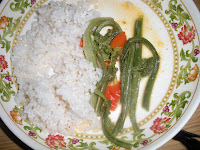
In my mind cold weather can only mean one thing food wise, comfort foods! This week there was a sudden cold snap and in response my mother made one of the most widely eaten Himalayan comfort foods- tingmo or tingmomo. Tingmo for the uninitiated is a sort of steamed bread that can be used to soak up everything from soup to curries to spicy pickle. I have heard it called the Himalayan version of white bread. When it comes out right, its wonderfully soft and fluffy and just a tiny bit greasy. My mother uses a standard white bread dough recipe with salt and yeast to make her tingmo ( thought I know other recipes out there sometimes call for sugar and soda). She mixes and kneads the dough and then leaves it in a covered bowl to rise a little. It will eventually be cooked in a the same kind of steamer as we use to make the fancier, better known Himalayan dumplings, momos.
The bottom most pan of the steamer will be filled with the water that will steam the tingmos. As it cooks the tingmos this water will become wonderfully greasy and tasty so that it actually can be made into a lovely soup to eat with the tingmos. So while I grease each layer of the pan my mother chops and fries onions and ginger before adding various chopped vegetables, whatever you have on hand, in this case it was cabbage, beans ,some potato and then of course she adds salt and water.
Next my mother works on further soften the dough by folding in more butter. Here is a photographic representation of how she does this:
1. She spreads chunks of butter onto rolled out dough
2. Then she cuts into the rolled out dough

3. She uses the cut to roll the dough

4. She roll, roll, rolls until she has a cone like shape

5. The she punches the dough back down so that it called be rolled out again

6. She repeats all this from the top a couple more times until she is confident that her dough will make the softest, fluffiest, yummiest tingmo.
Now it time to start shaping the tingmos and steaming them. My mother once again rolls out the dough and then she rolls the dough up, as seen below until she gets a long thin tube of dough.
She then uses a knife to cut circular slice off the tube. She then gently pulls on either end of the slice and joins it together, as seen below


And now they are ready to be placed in the steamer. Here are the tingmos before they are steamed.
And here they are once they are steamed .
And here they are served and ready to eat. In this case with some of the soup made in the same steamer and a tomato sauce made with generous amounts of chilli, onion and garlic with a little cheese added at the end.

















































